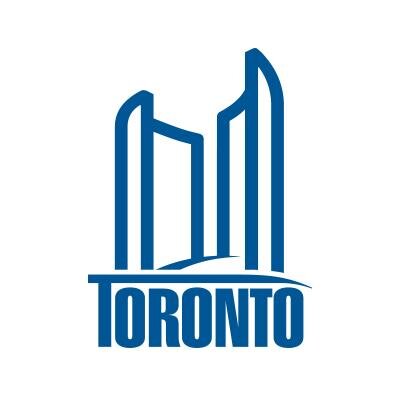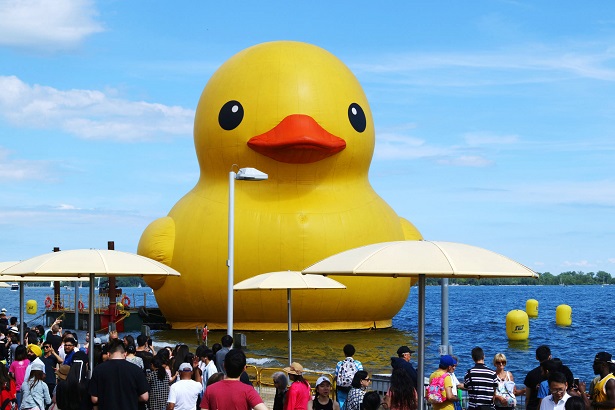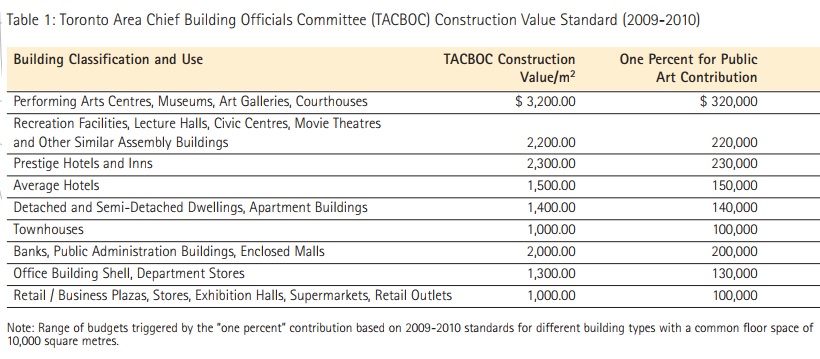What Percent of the Construction Costs of Art Is Standard
Well, if yous read Wednesday's blog, yous'll probably know it'southward therespondto Wednesday'due south weblog question: "What'due south the origin of the art in front of Toronto condos?"
Alas, developers aren't commissioning for the creation ofarton their own.
They're beingness forced to.
For those of you that thought people do good things of their own complimentary will and desire, sorry to burst your bubble on a Friday…

You just had to know this was coming, right?
The unabridged impetus for this blog post was a friend request me, "How come then many condo developers are incorporatingartinto the design of their new buildings?"
Um, they're not. Not past pick, anyways.
As with many things in life today, you can file this under the category of, "We're doing it considering the government is telling us to."
Toronto's "Percent For Public Art Plan" was implemented in 2010, merely the idea of incorporating art into urban center buildings dates back decades, from what I've read about the subject.
The origin tin be found in Section 37 of the Planning Act, which permits the City to authorize increases in permitted height and/or density through the zoning bylaw in return for community benefits.
Now do you lot run into where this is going?
Nosotros oft hear people muse things like, "…I'm sure urban center will let the developer builddoublethe height of any neighbouring edifice, so long as they build aparkette outside."
I've heard cynics say, "…so the developer got permission to build a tower 40% higher than the bylaw states, because he includedthreesubsidized housing units in a 400-unit condo?"
Give it five minutes, and I'1000 sure y'all could remember of five other like examples.
The words "in return for community benefits" have massive implications.
Out of Section 37 of The Planning Act came "The Percent For Public Art Plan," which you tin read at your leisure by clicking that link; all 40 pages of information technology.
The name comes from the idea that if you earmarked merelyi per centumof the cost of structure of a condominium forfine art, the metropolis would be a brighter, improve, more than beautiful place.
Okay, those are my words.
But I think "bright, better, cute" are in line with the thinking of many of today'southward politicians – maybe the aforementioned ones who putpicnic bencheson the road on King Street, in what used to exist a lane of traffic. But that'due south a topic for another day. A twenty-four hours, next twelvemonth, when we say, "Wow, has information technology been a year already?" upon the "pilot projection" becoming official…
Contemptuous? Yes.
Merely let'southward not forget that noteveryidea the City of Toronto has, is i that makes sense…

The offset page of the Pct For Public Art Program gives us this asset:
"Public fine art installations, both publicly and privately owned, make walking through the City's streets, open spaces and parks a delight for residents, workers and visitors alike." Section 3.1.4 TORONTO OFFICIAL PLAN, 2002
Equally I said, the entire concept of public art pre-dates the 2010 program.
So now comes the mission statement:
High quality public art is important to the enhancement of Toronto'due south urban fabric. Public art has created landmarks throughout the city and already contributes to the identity and grapheme of many of our neighbourhoods and districts. The City of Toronto has a broad definition of public art that provides artists with a variety of opportunities to enrich the urban environs. Public fine art can be unexpected moments of beauty, amusement, reflection or intrigue. These works of fine art might serve every bit monuments or memorials or correspond other creative, innovative and exploratory ideas or expressions for the area. Information technology is widely recognized that public art has the ability to heave economical development and tourism by making destinations for visitors and local residents. The side by side wave of urban center building brings with it the exciting opportunity of securing new public art installations across Toronto.
–
You can hold, or disagree.
As I wrote in Midweek's web log, we all take a different idea of what "art" is, and we all take a larger or smaller place for it in our lives.
When it comes topublicmoney, however, we deserve to know what'south going on, and we volition all have an opinion on effectiveness and necessity of regime expenditures, hence my inclusion of the condom ducky…
So now comes the rationale:
–
The feasibility of an on-site public art program is governed, in part, by the bachelor funding. Due to the size of contribution generally required to implement an effective public art program, on-site public fine art installations are primarily suited to larger-scale development (refer to Appendix ane: Upkeep Examples).
These guidelines recommend the "1 percentage for public art" model. This recommendation is based on common exercise institute within numerous successful public fine art programs in North America, Europe and other countries effectually the world. Information technology is the "tried and truthful" target that enables the public art to accept impact on the site in relation to the other 99% of the building budget.
Specifically, the recommended minimum public fine art contribution for a development should be based on one per centum of the gross structure cost (GCC) of that development. To obtain a standard interpretation for the GCC value, the calculation is to be derived from the virtually recent release of the Toronto Expanse Master Edifice Officials Commission'due south (TACBOC) Construction Value Standard (refer to Tabular array one for examples of contribution calculations). The TACBOC schedule reflects the average construction toll past edifice type inside the Greater Toronto Area and is the accepted method of calculating construction costs related to the issuance of edifice permits within the City of Toronto.
While a minimum value of 1% of gross structure costs is recommended for public art in evolution projects, that target may non be achievable on every project. In a large project, an on-site public art program with a value of less than ane% of gross construction costs may be feasible or advisable. In other smaller projects, a cash contribution towards off-site public art may be secured with a specified value comprising less than i% of gross structure costs.
Hither is the table mentioned:

–
Continue in mind, this table was included in the 2010 policy framework, thus the 2009-2010 numbers.
So now that we know what the program is, where and when information technology was derived, and how the tax, er, deplorable – I mean "contribution," is calculated, how does the developer make said contribution?
Equally per one of the post-obit:
In addressing the City'south policy framework for public art, the applicant has the post-obit options:
• 'On-site' Contribution: The applicant may commission public artwork to the value of the public fine art contribution (recommended one percent of the gross construction price of the development) and such works shall exist located upon the subject property or publicly owned lands adjacent thereto; or
• 'Off-site' (pooled) Contribution: The applicant may directly the value of the public art contribution to the Urban center's off-site pooled Public Art Reserve Fund. The fund volition be used towards City-supported public art plans on publicly endemic lands in the local community; or
• 'On-site/Off-site' Combination: The applicant may commission public art work on the subject property or publicly owned lands adjacent thereto and allocate the remaining portion of the public fine art contribution to the Metropolis's off-site pooled Public Art Reserve Fund to be used equally discussed in a higher place.
–
And then now you know how, where, and why we obtain "public art."
Developers tin either choose the "on site" contribution, and provide us with art like that which appeared in Wednesday's blog, or they can merely "contribute" to the "pooled" slush fund, er, deplorable – I hateful "reserve fund."
Merely I'k going to leave you with i last asset of information hither, folks.
My question, which could exist quite leading at this point, is very elementary:whopays for the artwork?
The 1% of construction costs, I mean.
The $2,000,000 paid to the artist, or the urban center, by the developer, when a condominium costs $200,000,000 to construct?
Yes – I know I said "by the developer" above, but that's not the answer.
Whoreallypays, in the end?
You lot.
The buyer of the condo.
If yous recall, for 1 2d, that developers – in betwixt ribbon-cutting ceremonies for these art projects, arereallygoing to pay for them, then you're as naive as the buyers that walk into the condo sales centres with no agents.
Hither's a sample "Argument of Adjustments" from a condo purchase, and note theboldeditem:
HST Rebate: $26,894.68
Deposit Administration Fee: $254.25
Involvement on deferred corporeality: $2,528.48
Mutual expenses: $1,223.84
Estimated 2014 reality taxes: $881.94
Estimated 2015 interim reality taxes: $1,749.50
Tarion fee: $971.80
Status Certificate: $100.00
Legal Fees Re Partial Discharge(s) (vendor mortgage discharge fees): $621.50
Bennett Jones LLP (builder'south lawyer): $975.75
Charge-Improvement/Art: $577.51
Hydro, Water Gas: $514.38
Educational activity: $614.72
Section 3: $9,409.51
Law Social club Levy: $73.45
2 Bedroom Levy: $half dozen,579.99
–
There you have it, folks.
$577.51 for an "fine art levy."
The fact that the buyer is paying for thearchitect'smortgage discharge, and thebuilder'slegal fees from Bennett Jones LLP, is a full blog mail service unto itself, as well as the idea of a "Section 3 Levy" which is completely unexplained, just I digress…
So while the urban center's efforts to bring fine art to our streets should exist applauded – because Ido, despite my political leanings/rantings, come across a public benefit in some of these projects, let's not pretend that this is something it'due south not.
Information technology's a tax on the heir-apparent, plain and simple.
Whether the City of Toronto knows, or knew, that the developer would simply accuse back their "art levies," and "education levies," and "greenspace levies," perhaps isn't the upshot.
But I certain as hell don't think it's fair to creditcondo developersfor "contributing" to the greater good, by providing art to the city streets, when information technology's an initiative forced on them by the City, and they're writing a cheque from the pocket of their condo-buyers.
Give the residents of Toronto the credit for this 1 for investing in culture and the arts, whether they knew they were paying for it, or not…
Back To Meridian
Back To Comments
Source: https://torontorealtyblog.com/blog/percent-public-art-program/
0 Response to "What Percent of the Construction Costs of Art Is Standard"
Post a Comment